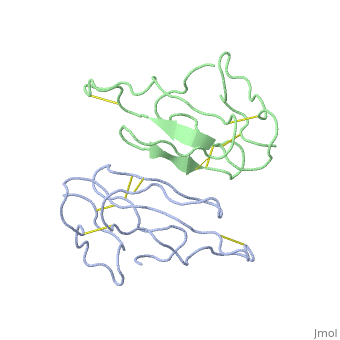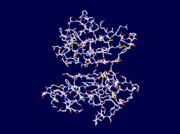Alpha-bungarotoxin
From Proteopedia
(Difference between revisions)
| Line 1: | Line 1: | ||
| - | + | <StructureSection load='2abx' size='350' side='right' scene='' caption=''> | |
| + | |||
=Alpha-Bungarotoxin= | =Alpha-Bungarotoxin= | ||
'''Alpha-[[Bungarotoxin]]''' (α-BGT) is a nicotinic cholinergic antagonist that is found within the venom of ''Bungarus multicinctus'', a South-asian snake belonging to a group commonly known as kraits. Belonging to the Elapidae Family, which consist of cobras, kraits, tiger snakes, and mambas, the venom of ''Bungarus multicuntus'' is a complex mixture of many different molecules<ref name="main">PMID: 3507686</ref> α-BGT belongs to a family of homologous proteins that act as a neurotoxic agent in the venom of these snakes. α-BGT is known to bind irreversibly to the acetylcholine receptor found at the neuromuscular junction, causing respiratory failure, paralysis, and death, as well as play an antagonstic role in binding the α7 nicotinic acetylcholine receptor in the brain. | '''Alpha-[[Bungarotoxin]]''' (α-BGT) is a nicotinic cholinergic antagonist that is found within the venom of ''Bungarus multicinctus'', a South-asian snake belonging to a group commonly known as kraits. Belonging to the Elapidae Family, which consist of cobras, kraits, tiger snakes, and mambas, the venom of ''Bungarus multicuntus'' is a complex mixture of many different molecules<ref name="main">PMID: 3507686</ref> α-BGT belongs to a family of homologous proteins that act as a neurotoxic agent in the venom of these snakes. α-BGT is known to bind irreversibly to the acetylcholine receptor found at the neuromuscular junction, causing respiratory failure, paralysis, and death, as well as play an antagonstic role in binding the α7 nicotinic acetylcholine receptor in the brain. | ||
| Line 26: | Line 27: | ||
==α7 nicotinic acetylcholine receptor binding== | ==α7 nicotinic acetylcholine receptor binding== | ||
Response to sensory stimuli and seizure genesis has been linked to nicotinic mechanisms<ref>PMID: 8478687</ref>, which are mediated by two major classes of receptors: Ganglionic type, and neuromuscular type, which pharmacological analysis of seizure genesis and habituation in the rat brain is thought to be mediated by the latter type <ref>PMID: 2813485</ref>. α-BGT demonstrates this relationship due to its prominent binding in the CA3 region of the hippocampus <ref>PMID: 626914</ref>. | Response to sensory stimuli and seizure genesis has been linked to nicotinic mechanisms<ref>PMID: 8478687</ref>, which are mediated by two major classes of receptors: Ganglionic type, and neuromuscular type, which pharmacological analysis of seizure genesis and habituation in the rat brain is thought to be mediated by the latter type <ref>PMID: 2813485</ref>. α-BGT demonstrates this relationship due to its prominent binding in the CA3 region of the hippocampus <ref>PMID: 626914</ref>. | ||
| - | + | </StructureSection> | |
==3D structures of Alpha-bungarotoxin== | ==3D structures of Alpha-bungarotoxin== | ||
Revision as of 14:37, 13 January 2016
| |||||||||||
3D structures of Alpha-bungarotoxin
Additional Resources
For additional information, see: Toxins
References
- ↑ 1.0 1.1 1.2 1.3 1.4 1.5 Love RA, Stroud RM. The crystal structure of alpha-bungarotoxin at 2.5 A resolution: relation to solution structure and binding to acetylcholine receptor. Protein Eng. 1986 Oct-Nov;1(1):37-46. PMID:3507686
- ↑ Karlsson, E. (1979) in Lee,C Y (ed), Handbook of Experimental Pharmacology Springer-Verlag, Berlin Vol 52, pp 159-212;Low, B.W. (1979) In Lee,c Y (ed). Handbook of Experimental Pharmacology Springer-Verlag, Berlin, Vol 52, pp 213-257.
- ↑ Tu AT, Hong BS. Purification and chemical studies of a toxin from the venom of Lapemis hardwickii (Hardwick's sea snake). J Biol Chem. 1971 May 10;246(9):2772-9. PMID:5554293
- ↑ Chiceportiche, R. Rochat, C. Sampien, F. Lazdunski, M. (1972) Biochemistry 14, 2081-2091;Chen, Y.H. Tai, J.C. Huand, W.J. Lau, M.Z. Hung, M.C. Lai, M.D. Yang, J.T. (1982) Biochemistry 21 2592-2600
- ↑ Berg DK, Kelly RB, Sargent PB, Williamson P, Hall ZW. Binding of -bungarotoxin to acetylcholine receptors in mammalian muscle (snake venom-denervated muscle-neonatal muscle-rat diaphragm-SDS-polyacrylamide gel electrophoresis). Proc Natl Acad Sci U S A. 1972 Jan;69(1):147-51. PMID:4333037
- ↑ Freedman R, Wetmore C, Stromberg I, Leonard S, Olson L. Alpha-bungarotoxin binding to hippocampal interneurons: immunocytochemical characterization and effects on growth factor expression. J Neurosci. 1993 May;13(5):1965-75. PMID:8478687
- ↑ Miner LL, Collins AC. Strain comparison of nicotine-induced seizure sensitivity and nicotinic receptors. Pharmacol Biochem Behav. 1989 Jun;33(2):469-75. PMID:2813485
- ↑ Hunt SP, Schmidt J. The electron microscopic autoradiographic localization of alpha-bungarotoxin binding sites within the central nervous system of the rat. Brain Res. 1978 Feb 17;142(1):152-9. PMID:626914
Proteopedia Page Contributors and Editors (what is this?)
Alexander Berchansky, Michal Harel, Simon Loewen, David Canner


